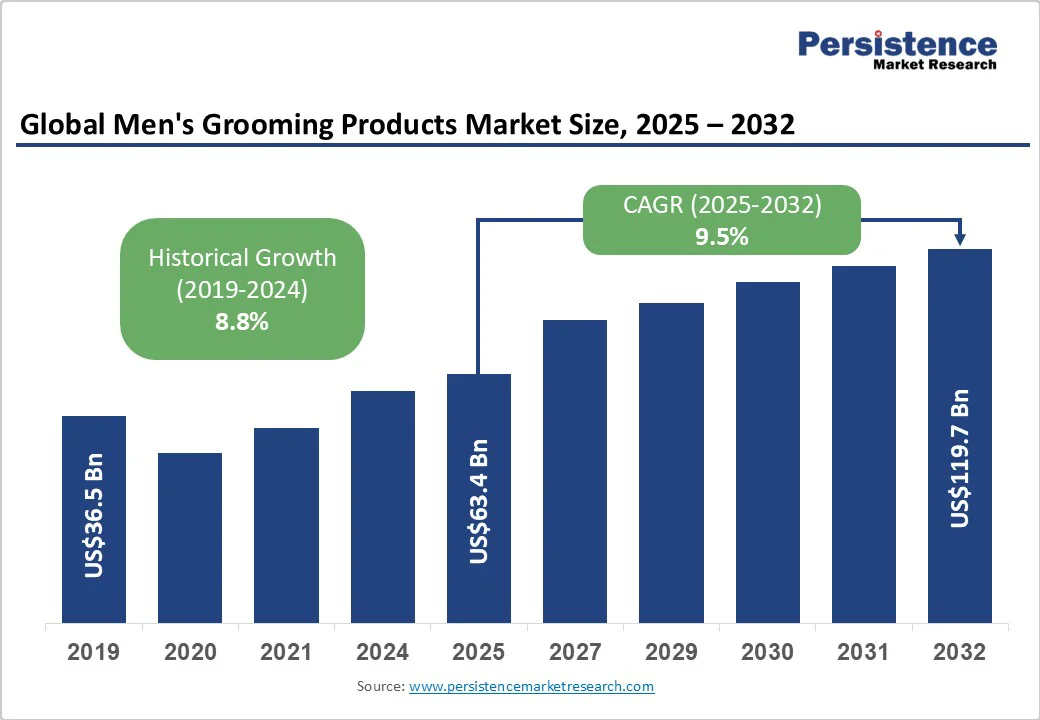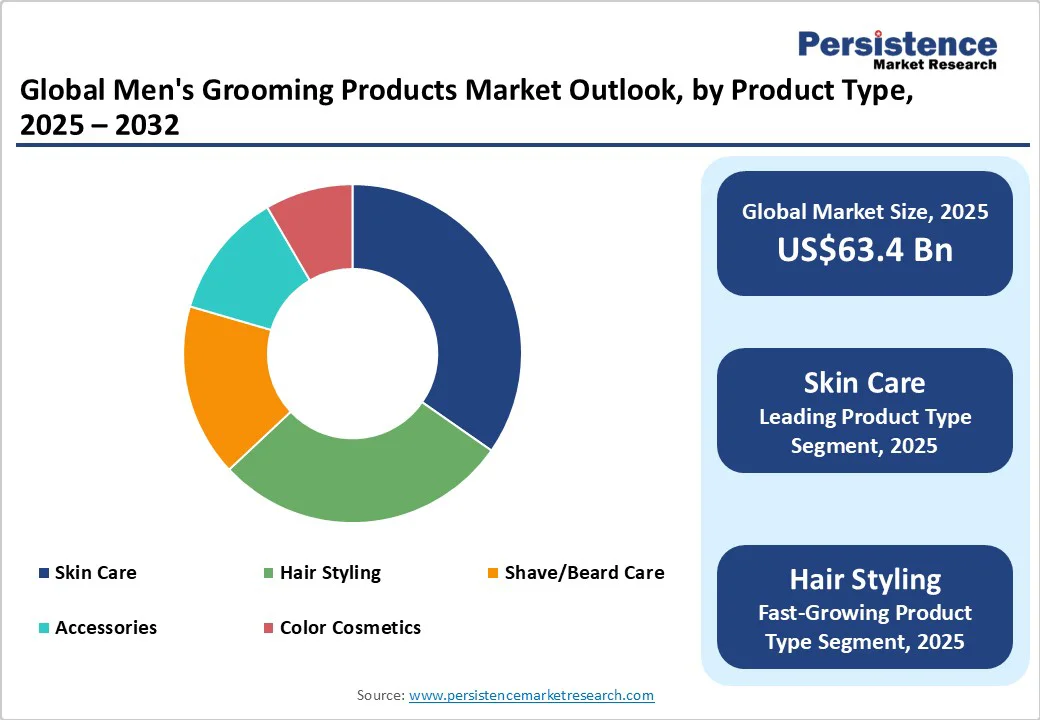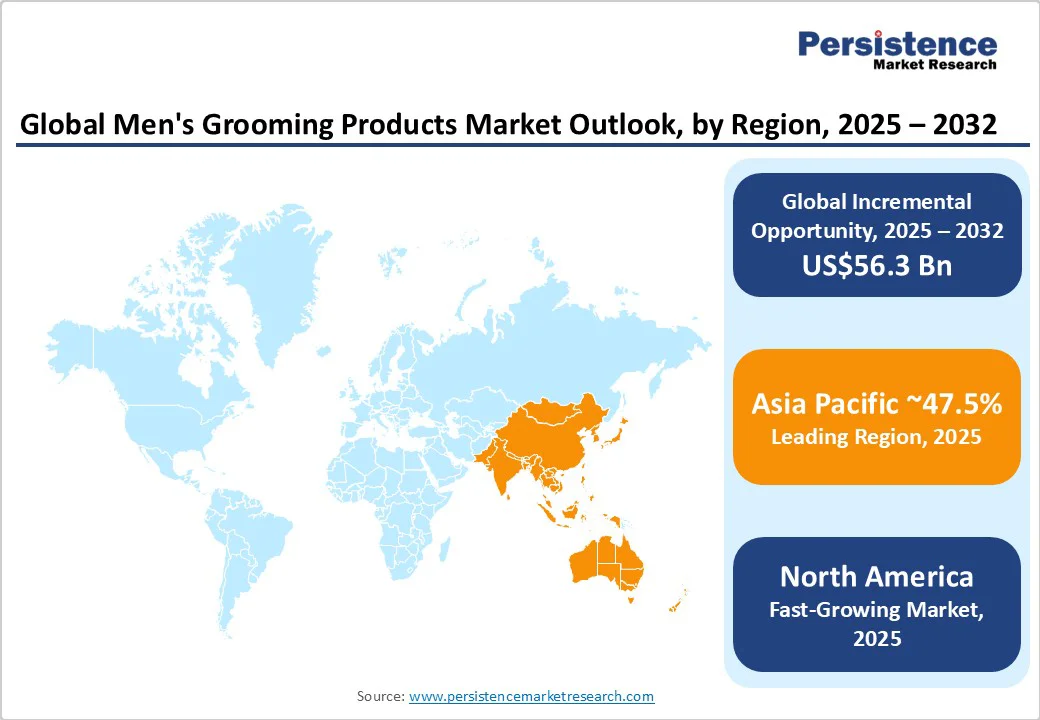ID: PMRREP11581| 192 Pages | 8 Oct 2025 | Format: PDF, Excel, PPT* | Consumer Goods

The global men's grooming products market size is likely to be valued at US$63.4 Billion in 2025 and is estimated to reach US$119.7 Billion in 2032, growing at a CAGR of 9.5% during the forecast period 2025-2032, fueled by rising awareness around skincare, haircare, and hygiene. Social media and influencer culture have also fueled grooming trends, normalizing routines that were once considered niche.
| Key Insights | Details |
|---|---|
|
Men's Grooming Products Market Size (2025E) |
US$63.4 Billion |
|
Market Value Forecast (2032F) |
US$119.7 Billion |
|
Projected Growth (CAGR 2025 to 2032) |
9.5% |
|
Historical Market Growth (CAGR 2019 to 2024) |
8.8% |

Men today are showing greater awareness of personal grooming, extending beyond shaving to skincare, haircare, and body hygiene. Social media and influencer culture have played a key role in normalizing male self-care routines and challenging outdated stereotypes. Young generations, particularly Gen Z, actively engage with grooming content online and seek products that address specific concerns, including acne, hair loss, or beard maintenance.
The surging availability of men-focused product lines such as L’Oréal Men Expert’s Hydra Energetic range and Beardo’s charcoal skincare line reflects this behavioral shift. Even in India and Southeast Asia, e-commerce platforms such as Nykaa Man and Tmall Global are witnessing strong growth in male grooming categories, signaling that grooming is now an essential part of modern male identity rather than a luxury.
Men’s grooming has evolved into a component of wellness, where physical appearance, mental balance, and self-confidence are interlinked. Modern consumers view grooming as a form of self-care that helps them feel composed and motivated in daily life. Brands are responding by introducing products infused with natural or mood-enhancing ingredients such as caffeine-based cleansers and aromatherapy-infused beard oils.
For example, Dove Men+Care’s Care for Every Man campaign emphasizes emotional well-being alongside hygiene, while Papatui, launched by Dwayne Johnson, emphasizes clean, vegan formulas designed for everyday confidence. This wellness-driven narrative has broadened the market’s appeal, encouraging men to adopt consistent and mindful routines that comply with their health and lifestyle goals.
One of the major challenges in the global market is the increasing incidence of skin irritation and allergic reactions caused by synthetic ingredients, harsh chemicals, and artificial fragrances. As men experiment with multiple products, overlapping formulations can trigger breakouts, redness, or dryness, especially for those with sensitive skin.
This has led to rising skepticism toward chemical-heavy grooming brands. A 2024 survey found that nearly 42% of male consumers now check ingredient labels before purchase, reflecting rising caution. Brands such as Bulldog Skincare and The Man Company have responded with sulfate- and paraben-free products to reduce irritation risks.
Another key restraint is the industry’s continued reliance on overly masculine and gendered marketing, which often alienates a large section of potential consumers. Multiple brands still focus on clichés such as ruggedness or power, neglecting men who seek subtle, minimalist, or gender-neutral options.
As grooming becomes a self-care activity rather than a symbol of masculinity, this outdated branding approach feels exclusionary. According to a 2024 Euromonitor report, nearly one in three men prefer gender-neutral packaging and messaging when buying personal care products. Progressive brands such as Hims, Non Gender Specific, and Humanrace are successfully appealing to modern consumers by promoting inclusivity and emotional well-being.
The global rise in facial hair trends has fueled a wave of innovation in beard grooming and maintenance products. Beards have become a fashion and identity statement, prompting men to invest in specialized products such as beard oils, conditioners, and styling balms. This shift is visible across both Western and Asian markets, where influencers and barbershop culture have normalized beard grooming as part of daily routines.
Brands such as Honest Amish, Ustraa, and King C. Gillette are introducing nutrient-rich oils with natural ingredients, including argan and jojoba, to target beard health and texture. Social media platforms such as Instagram and YouTube have raised the popularity of beard-care tutorials, pushing consumers toward more premium and personalized products.
Sustainability has become a key growth opportunity in the men’s grooming products market, with consumers showing increasing concern about plastic waste and the environmental footprint of personal care products. Several brands are transitioning to biodegradable or reusable packaging, introducing refill pouches, glass containers, and bamboo-based materials to replace single-use plastics.
For example, Bulldog Skincare’s bamboo razor and Lush’s naked (packaging-free) shaving products are attracting eco-conscious buyers. Similarly, Beardo and The Body Shop have begun providing refill stations and recyclable bottles across select stores to encourage repeat use.
Skin care is expected to account for approximately 34.7% of the market share in 2025 as modern consumers are more conscious about maintaining healthy, youthful skin. With rising exposure to pollution, blue light, and stress, men are now addressing issues such as dullness, acne, and premature aging through daily routines. The availability of male-specific products, including moisturizers with SPF, exfoliating face washes, and serums targeting oil control, has made skincare more accessible and practical.
Hair styling holds a significant place in men’s grooming as hairstyles remain a core aspect of male identity and self-expression. Modern men experiment with textures, colors, and styling techniques, pushing demand for unique pomades, waxes, clays, and sprays that deliver flexibility without residue. The rise of professional barbering culture and salon-grade products such as American Crew, Layrite, and Schwarzkopf’s Osis+ line has redefined hair styling as an everyday ritual rather than an occasional requirement.
The mass segment will likely hold a share of around 73.3% in 2025, as mass products provide affordability and accessibility across both urban and rural markets. Most men prefer simple, functional products that deliver quick results without requiring a complex routine, making budget-friendly options highly attractive. Brands such as Nivea Men, Garnier Men, and Gillette have built strong loyalty by providing reliable performance at reasonable prices through supermarkets, pharmacies, and e-commerce channels.
The premium men’s grooming category is expanding as consumers associate grooming with self-care, wellness, and individuality. Men are now willing to spend more on high-quality, dermatologist-tested, and ingredient-focused products that promise superior results. Brands such as Kiehl’s, Jack Black, and Clinique for Men are gaining momentum for using clean, cruelty-free, and scientifically backed formulations. The rise in disposable income among millennials and professionals has further supported this shift toward indulgent grooming experiences.
The online channel is estimated to account for nearly 63.7% of the market share in 2025, as it provides convenience, privacy, and access to a wide range of products that may not be available in local stores. E-commerce platforms allow consumers to compare prices, read reviews, and choose niche or international brands easily. Subscription models such as those from Harry’s and Dollar Shave Club have also popularized auto-refills and doorstep delivery.
Despite the rise of e-commerce, offline retail channels continue to see growth as they provide tactile experiences and immediate product access, which is important for grooming products. Men often prefer testing textures, scents, and finishes of skincare, hair, or beard care items before committing to a purchase. Barbershops and in-store grooming sections are now serving as experiential hubs, where consumers receive advice and try premium products firsthand.

In 2025, Asia Pacific is speculated to account for approximately 47.5% of the market share, owing to evolving cultural norms, increased disposable income, and a rising emphasis on personal care among men. Consumer preferences in the region vary significantly across different countries. In Japan, for instance, there is an ongoing inclination toward high-quality, multifunctional products customized for specific skin concerns such as dryness and dullness.
Brands such as Varon have introduced all-in-one lotions and moisturizers targeting middle-aged men, addressing these specific requirements. However, in India, the market is witnessing a high demand for natural and organic grooming products. Local start-ups and international brands are hence customizing their portfolios to cater to the unique climatic conditions and cultural preferences.
North America's market is experiencing a significant transformation, fueled by shifting cultural perceptions and increased consumer engagement. Men are extensively adopting grooming routines that encompass skincare, haircare, and shaving products, reflecting a broad societal trend toward self-care and wellness.
This shift is evident in the rising popularity of multifunctional products that cater to convenience and efficiency requirements, such as all-in-one cleansers and moisturizers. Also, the rise of digital platforms and social media has facilitated greater exposure to global grooming trends, influencing consumer preferences and purchasing behaviors.
Celebrity-backed grooming brands in Europe are making a significant impact in the market. These brands utilize the influence and credibility of celebrities to connect with consumers and promote their products. For instance, David Beckham's House 99, developed in partnership with L'Oréal, provides a range of grooming products that reflect Beckham's personal style and grooming rituals.
Similarly, Dwayne ‘The Rock’ Johnson's Papatui line, available at Target, focuses on accessible skincare with clean ingredients, aiming to normalize men's skincare discussions. These celebrity-led initiatives resonate with consumers seeking authenticity and quality in their grooming choices. These contribute to the surging trend of personalized and influencer-driven beauty.

The global men's grooming products market is highly competitive with global giants, indie start-ups, and celebrity-backed brands all fighting for relevance. Established players such as Unilever, Procter & Gamble, and L’Oréal dominate retail shelves but are rapidly diversifying their portfolios through acquisitions and new product launches. Direct-to-consumer and subscription-based brands have transformed how men buy grooming products. Another major development is the rise of indie and celebrity-backed brands that connect with consumers through authenticity and social media influence.
Business Strategies
Market leaders in men’s grooming focus on innovation through natural, multifunctional, and tech-driven formulations. Cost leadership is achieved through efficient supply chains and subscription models. Market expansion targets emerging regions and online channels. Key differentiators include clean ingredients, personalization, and influencer branding. Emerging trends involve refillable packaging, D2C models, and celebrity-led product lines.
The men's grooming products market is projected to reach US$63.4 Billion in 2025.
The market is driven by growing male awareness of personal care and the influence of social media.
The men's grooming products market is poised to witness a CAGR of 9.5% from 2025 to 2032.
Expansion of the beard care segment and the launch of refillable packaging are the key market opportunities.
Beiersdorf AG, L'Oréal Groupe, and Procter & Gamble Co. are a few key market players.
| Report Attribute | Details |
|---|---|
|
Historical Data/Actuals |
2019 - 2024 |
|
Forecast Period |
2025 - 2032 |
|
Market Analysis |
Value: US$ Bn |
|
Geographical Coverage |
|
|
Segmental Coverage |
|
|
Competitive Analysis |
|
|
Report Highlights |
|
By Product Type
By Price Range
By Distribution Channel
By Region
Delivery Timelines
For more information on this report and its delivery timelines please get in touch with our sales team.
About Author